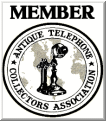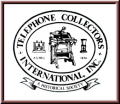| The Western
Electric compact wall phones were initially
small wood models and shortly thereafter of
copper plated sheet metal composition having
two coats of black enamel paint. WE compact
wall phones, although fairly plain, have
always been a favorite of mine. I find them
highly desirable, as they require minimal
wall space for display. Finding exceptional
examples with the wood or metal in good
original displayable condition is always
difficult. All examples displayed here
retain their original finish and ALL parts
are original other than some cords. On rare
occasion accessories have been re-nickeled
if necessary. |
| There are a lot of images on
these pages, please be patient when downloading. |


|
|
#293A Compact Wall Telephone |
|
c.
1905-1915 - I liked
this compact walnut phone because it was a bit different as
it is stamped Special Type 293A. The noticeable difference
is the second lower receiver hook that is spring loaded, to
secure the receiver.
This application could have been for special use on a ship
or train. It is the earlier style of this model, having the
early lock mechanism and the door hinges with patent info "PAT'D
NOV 16 1886" stamped into them.
Equipped with a beveled
face transmitter marked "WESTERN ELECTRIC COMPANY". |
|
#293Y Compact Wall Telephone |
| c. 1905-1915 - I liked this compact walnut phone because
it is in primo condition and is a bit different as it is
stamped 293Y. The noticeable difference is internal parts,
as this application was produced for local battery talking
and central battery signaling. Again, early lock mechanism
and the door hinges with patent info. |
|
#293
Compact Wall Phone (Later Style) |
| c. 1907-1915 Later style wood 293A. Updated switch arm
with escutcheon plate and door latch. No longer is patent
info stamped into the side of box but on a tag located
inside of door. Envelope containing paper with electrical
schematics. NOTE: Original red bakelite mouthpiece (as
opposed to oxblood red m/p displayed
here.) |
|
#333
Compact Wall Telephone |
| c. 1909-1916 - Other than magneto sets, wood cases were
disappearing, being replaced by sets that were metal which
was copper plated. The #333 was the first of this type. It
is very desirable among collectors maybe because it is the
first model with the smooth metal look, or that it is very
attractive with the gongs located on the outside of the box.
This makes it very attractive, especially when the gongs are
nickel plated. NOTE: Very nice porcelain mouthpiece
with brass threads and patent date Nov. 14, 1911. |
| c. 1910's - Interesting variation that is almost a cross
between a #333 and #533. Except for some subtle exceptions,
it has the size and look of a #333 with outside gongs, yet
has the stamped window frame front like the #533. Equipped
with a 143 receiver and 325W flush mount transmitter and
considering its size, it is likely a Private Line Telephone
Set used to connect rooms, or departments, or house with a
stable or barn. The only model identifiers is "12KY" stamped
on backside. I have never seen another and have been unable
to find this phone in any catalog. Any info would be
appreciated. |
| c. 1910's - With this wall model, the gongs were now
placed inside the box subsequently making it a basic
rectangular box with a sort of picture frame stamped into
the front of the door. The second example is a #533 with a
dial added. As the dial was introduced and Western Electric
was always looking to save a dollar, an adapter, called the
37A, was designed to allow older manual wall sets to convert
to machine switching service, ie: to accommodate a dial.
Made of metal with a black finish, it was designed to
attach to the front of the phone allowing for integrating a
dial. These adapters extended the life of some #333 and #533
models well into the 1930's. Today these adapters are hard
to find
Very nicely marked 143 receiver.
(A 37A mounted to a #333 wall phone can be viewed in
Mountjoys, 100 Years of Bell Telephones, top left of
page 134.) |
|
#553 Compact Wall Telephone |
| c. 1920's-1930's - This model is the same black box as
the #533 updated to accommodate a dial. I believe the
addition of the dial and relocation of the transmitter makes
the phone more attractive. The #553 was followed up by the
#653, which was identical in outward appearance, but
anti-sidetone. |
|
#653 Compact Wall Telephone |
| c. 1930's-1940's - This model is identical in appearance
to the #553 on the outside, just updated to anti-sidetone.
(View the #553 above.) In order to be informative, yet not
redundant, I have chosen to display a #653 that was factory
updated to accommodate a handset. This one is labeled
SP653AC and also has a D#, which usually was a designation
for some sort of trial, testing or prototype. I have left
everything as was with this model. This type of "updating"
was not unusual. |

phonemandave.net/westernelectric
compact wall phones
|
|